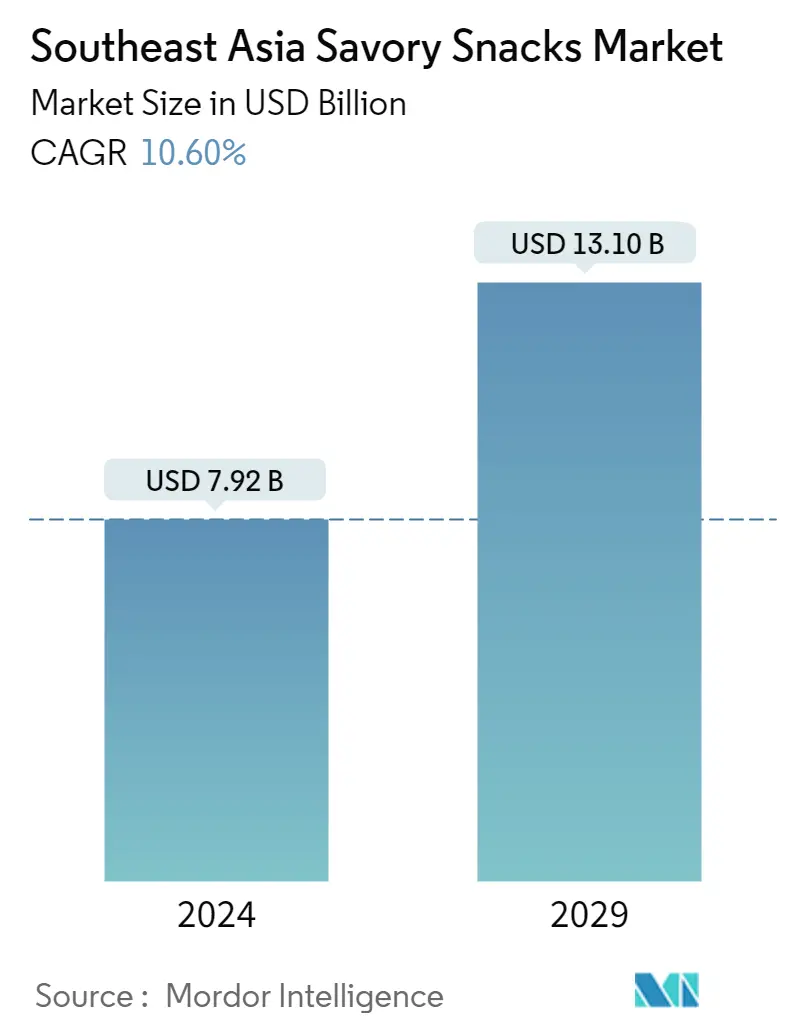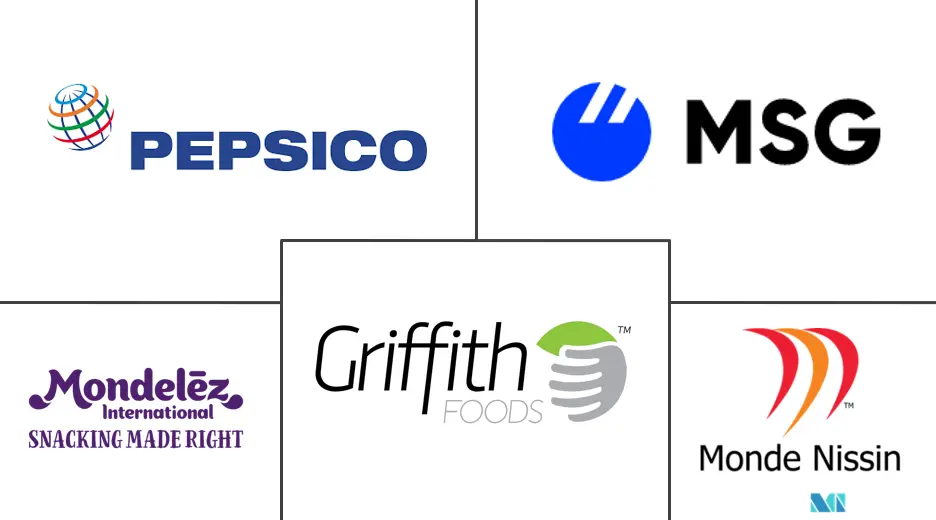Market Size of Southeast Asia Savory Snacks Industry

| Study Period | 2018 - 2029 |
| Base Year For Estimation | 2023 |
| Market Size (2024) | USD 7.92 Billion |
| Market Size (2029) | USD 13.10 Billion |
| CAGR (2024 - 2029) | 10.60 % |
| Market Concentration | Low |
Major Players
*Disclaimer: Major Players sorted in no particular order |
Southeast Asia Savory Snacks Market Analysis
The Southeast Asia Savory Snacks Market size is estimated at USD 7.92 billion in 2024, and is expected to reach USD 13.10 billion by 2029, growing at a CAGR of 10.60% during the forecast period (2024-2029).
The market studied is driven by increasing demand for convenience food products and an on-the-go trend for snacking options. Snack manufacturers in Southeast Asia are challenged by competitors coming up with traditional and new flavors. The most consumed snack type is nuts and seeds, consisting of sunflower seeds, pumpkin seeds, walnuts, and trail mixes, among others, driven by the health-conscious population. Popcorn is the fastest-growing product type in the market, attributed to its presence in various leisure spots and the incorporation of various flavors and convenient packing.
In terms of processing methods, frying was the most used, owing to the ease of processing. However, extrusion methods are growing in popularity in the region due to the growing health concerns regarding frying. A significant trend across all markets is the smaller package sizes to encourage more frequent snacking by making it both convenient and easier to control portions. New extrusion methods bring more puffed, popped, dried, and crisped textures to salty snacks. Puffed and extruded snacks are experiencing a renaissance, providing more choices for consumers to choose from traditional, healthier, and even 'free-from' options, like gluten-free. Whole grains are getting in on the action, including specialty grains, like quinoa, whereas pulses, legumes, and vegetables also go into the mix of nutritional flours such as hemp. For instance, in February 2022, Thailand's Srinanaporn Marketing Public Company Limited (SNNP), the Jele, Lotus, and Bento maker, launched Lotus Drumstick with hemp seed flour and seaweed flavor. The new product was the snack in Thailand to come with hemp seeds which were available at 7-Eleven.
Southeast Asia Savory Snacks Industry Segmentation
Savory food has a salty or spicy flavor rather than a sweet one. The Southeast Asian savory snacks market is segmented by product type, distribution channel, and country. By product type market is segmented into extruded snacks, meat snacks, popcorn, fruit and vegetable snacks, potato chips, nuts and seeds, and other savory snacks. The market is further segmented by distribution channel into supermarkets/hypermarkets, convenience stores, online retail stores, specialty stores, and other distribution channels. The market is also segmented by country into Indonesia, Malaysia, Vietnam, Thailand, Philippines, Myanmar, Singapore, and the Rest of Southeast Asia. For each segment, the market sizing and forecasts have been done based on value (in USD million).
| Product Type | |
| Extruded Snacks | |
| Meat Snacks | |
| Popcorn | |
| Fruit and Vegetable Snacks | |
| Potato Chips | |
| Nuts and Seeds | |
| Other Savory Snacks |
| Distribution Channel | |
| Spermarkets/Hypermarkets | |
| Convenience Stores | |
| Online Retail Stores | |
| Specialty Stores | |
| Other Distribution Channels |
| Country | |
| Indonesia | |
| Malaysia | |
| Vietnam | |
| Thailand | |
| Philippines | |
| Myanmar | |
| Singapore | |
| Rest of Southeast Asia |
Southeast Asia Savory Snacks Market Size Summary
The Southeast Asian snacks market is experiencing significant growth, driven by an increasing demand for convenience foods and on-the-go snacking options. The market is characterized by a diverse range of snack types, with nuts and seeds being the most consumed due to the health-conscious consumer base. Popcorn is emerging as the fastest-growing product, benefiting from its availability in leisure spots and the introduction of various flavors and convenient packaging. The market is also witnessing a shift towards healthier processing methods, with extrusion gaining popularity over traditional frying due to health concerns. This trend is accompanied by a focus on smaller package sizes to encourage frequent snacking and better portion control. Innovations in snack textures and ingredients, such as the use of whole grains, pulses, and legumes, are catering to the growing demand for healthier and 'free-from' options, including gluten-free snacks.
The competitive landscape of the Southeast Asian snacks market is marked by the presence of both domestic and international players, with companies like Monde Nissin Food Company, PepsiCo Inc., and Mondelēz International leading the charge. These companies are focusing on product development and innovation to meet evolving consumer preferences for taste and quality. The market is also seeing a rise in localized flavors and exotic ingredients, particularly in Indonesia, where consumers are increasingly seeking tasty, nutritional, and sustainable snack options. The introduction of low-sodium and health-focused products, such as those made with hemp seed flour and seaweed flavor, reflects the growing consumer consciousness around health and wellness. As consumers continue to prioritize organic and non-GMO labels, the market is poised for further expansion, driven by strategic product launches and a commitment to meeting the diverse needs of snackers across the region.
Southeast Asia Savory Snacks Market Size - Table of Contents
-
1. MARKET DYNAMICS
-
1.1 Market Drivers
-
1.2 Market Restraints
-
1.3 Porter's Five Forces Analysis
-
1.3.1 Threat of New Entrants
-
1.3.2 Bargaining Power of Buyers/Consumers
-
1.3.3 Bargaining Power of Suppliers
-
1.3.4 Threat of Substitute Products
-
1.3.5 Intensity of Competitive Rivalry
-
-
-
2. MARKET SEGMENTATION
-
2.1 Product Type
-
2.1.1 Extruded Snacks
-
2.1.2 Meat Snacks
-
2.1.3 Popcorn
-
2.1.4 Fruit and Vegetable Snacks
-
2.1.5 Potato Chips
-
2.1.6 Nuts and Seeds
-
2.1.7 Other Savory Snacks
-
-
2.2 Distribution Channel
-
2.2.1 Spermarkets/Hypermarkets
-
2.2.2 Convenience Stores
-
2.2.3 Online Retail Stores
-
2.2.4 Specialty Stores
-
2.2.5 Other Distribution Channels
-
-
2.3 Country
-
2.3.1 Indonesia
-
2.3.2 Malaysia
-
2.3.3 Vietnam
-
2.3.4 Thailand
-
2.3.5 Philippines
-
2.3.6 Myanmar
-
2.3.7 Singapore
-
2.3.8 Rest of Southeast Asia
-
-
Southeast Asia Savory Snacks Market Size FAQs
How big is the Southeast Asia Savory Snacks Market?
The Southeast Asia Savory Snacks Market size is expected to reach USD 7.92 billion in 2024 and grow at a CAGR of 10.60% to reach USD 13.10 billion by 2029.
What is the current Southeast Asia Savory Snacks Market size?
In 2024, the Southeast Asia Savory Snacks Market size is expected to reach USD 7.92 billion.

